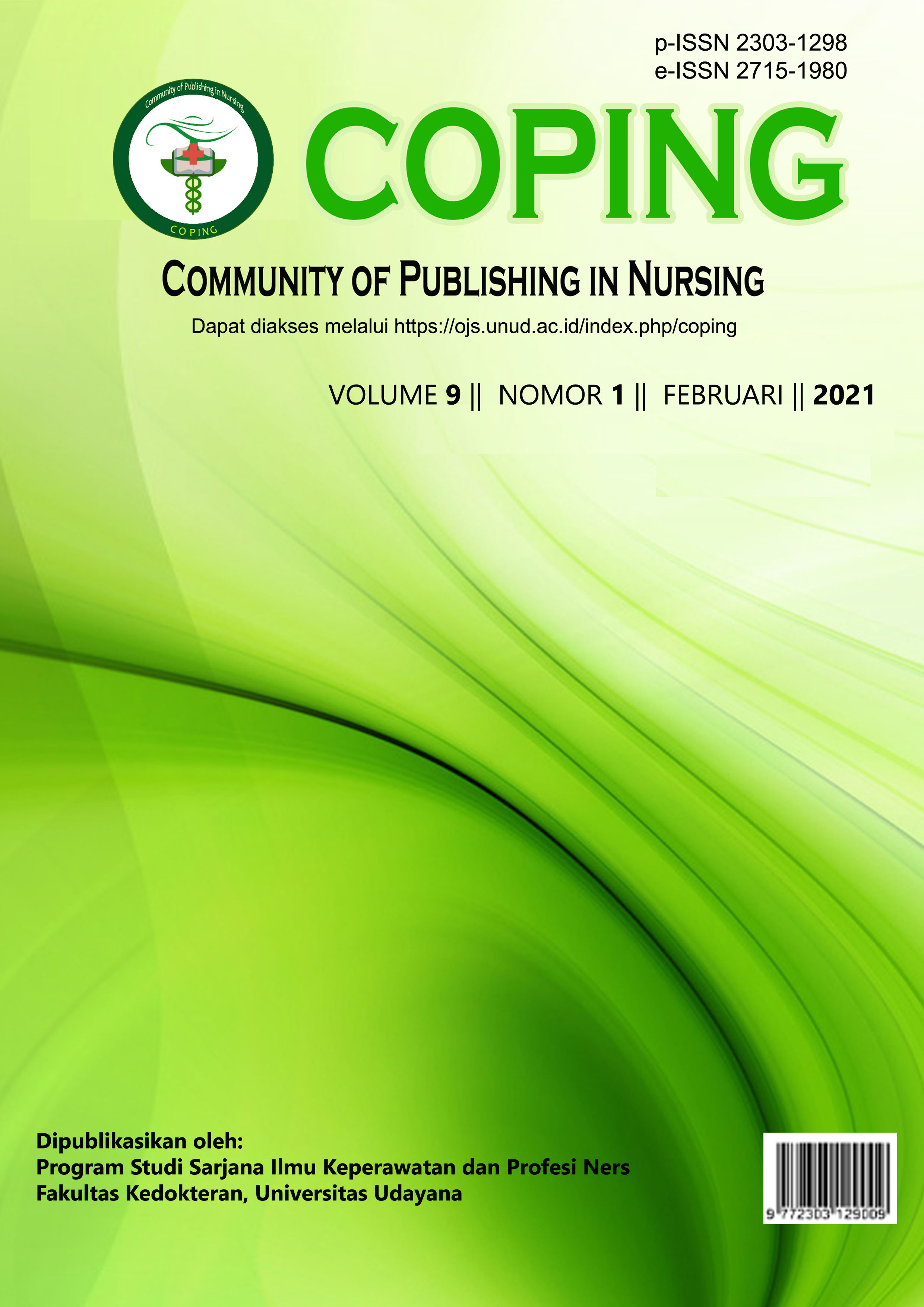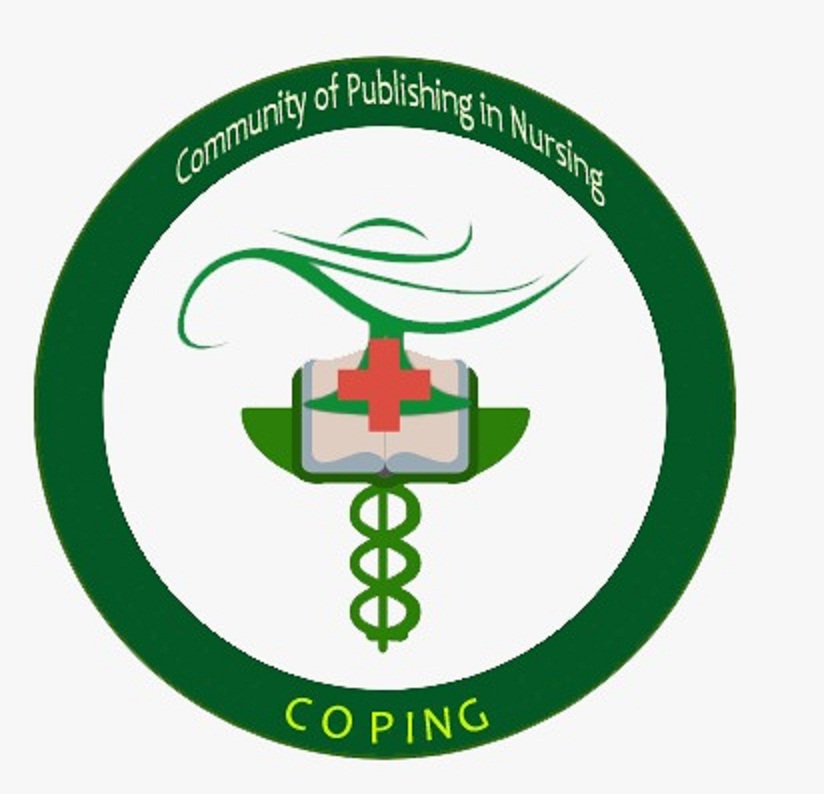FAKTOR-FAKTOR YANG BERHUBUNGAN DENGAN HEALTH LITERACY PADA MAHASISWA KEPERAWATAN DI UNIVERSITAS UDAYANA DENPASAR, BALI
Abstract
Health literacy is one of health determinants. Low use of healthcare, preventine services, and less participation of health promoting behaviours are associated with low level of health literacy. Health literacy levels of nursing students are important because nursing student is a future healthcare profesional who has vital role as an educator. The aimed of this study is to asses the related factors of health literacy of nursing student in Udayana University. The study types is descriptive correlative with cross-sectional approach. Proportionate Stratified Random Sampling was applied and this study conducted with 148 participants from four different grades. This study used Participants Characteristic Form and Short-Form Health Literacy Survey Tool (HLS-SF-12) as data collection tool. Descriptive statistics, Central Tendency, Gamma correlation analysis, and Contingency Coefficent correlation analysis were used for data analysis. The result of statistic test showed that no significant correlation between grades, gender, parents highest educational level, presence of health problem, and frequency of internet use for health purposes with health literacy (p=0,232) of nursing student in Udayana University. Nursing students in Udayana University have a low level of health literacy. Health literacy levels of nursing student play an important role for their health and role as health professional in the future. Based on this study result, it is suggest for nursing lecturer to intergrated and addressed health literacy into student learning process like include health literacy in health promotion subject.
Downloads
References
Bonnie, R. J., Stroud, C., & Breiner, H. (2015). Young Adults in the 21st Century. National Academies Press (US). Retrieved from: https://www.ncbi.nlm.nih.gov/books/NBK284782/
Duong, T. V., Aringazina, A., Baisunova, G., Nurjanah, Pham, T. V., Pham, K. M., Truong, T. Q., Nguyen, K. T., Oo, W. M., Mohamad, E., Su, T. T., Huang, H.-L., Sørensen, K., Pelikan, J. M., Van den Broucke, S., & Chang, P. W. (2017). Measuring Health Literacy in Asia: Validation of the HLS-EU-Q47 Survey Tool in Six Asian Coutries. Journal of Epidemiology, 27(2), 80–86. doi: 10.3928/24748307-20190225-01
Erunal, M., Ozkaya, B., Mert, H., & Kucukguclu, O. (2019). Investigation of Health Literacy Levels of Nursing Students and Affectiong Factors. 11(3), 11.
Febriani, W. M. (2019). Gambar Perilaku Pencarian Pengobatan pada Mahasiswa Fakultas Kesehetan Masyarakat di Universitas Airlangga, Jurnal PROMKES, 7(2), 193. doi: 10.20473/jpk.V7.I2.2019.193-203
Holt, K. A., Overgaard, D., Engel, L. V., & Kayser, L. (2020). Health Literacy, Digital Literacy, and eHealth Literacy in Danish Nursing Students at Entry and Graduate Level: A Cross Sectional Study, BMC Nursing, 19(1), 22. doi: 10.1186/s12912-020-00418-w
Kennard, D. K. (2016). Health Literacy Concepts in Nursing Education. 2.
Kickbusch, I., Pelikan, J. M., Apfel, F., & Tsouros, A. D. (2013). Health literacy: The solid facts. World Health Organization Regional Office for Europe.
Kolnik, T. Š., Hozjan, D., & Babnik, K. (2017). Health Literacy and Health Related Lifestyle Among Nursing Students. Pielegniarstwo XXI Wieku / Nursing in the 21st Century, 16(2), 42–46. doi: 10.1515/pielxxiw-2017-0017
Lau, J. S., & Neinstein, L. (2017). Young Adult Health and Well-Being: A Position Statement of the Society for Adolescent Health and Medicine. Journal of Adolescent Health, 60(6), 758–759. doi: 10.1016/j.jadohealth.2017.03.021
McCleary-Jones, V. (2012). Assessing Nursing Students’ Knowledge of Health Literacy: Nurse Educator, 37(5), 214–217. doi: 10.1097/NNE.0b013e318262ead3
Ozen, N., Bal Ozkaptan, B., Coskun, S., & Terzioglu, F. (2019). Health Literacy of Nursing Students and Its Effective Factors. Nursing Forum, 54(3), 396–402. doi: 10.1111/nuf.12346
Park, H., & Lee, E. (2015). Self-reported eHealth Literacy among Undergraduate Nursing students in South Korea: A pilot study. Nurse Education Today, 35(2), 408–413. doi: 10.1016/j.nedt.2014.10.022
Setyawan, M. B. (2017). Hubungan Penggunaan Smartphone dengan Health Literacy pada Perawat di RSU Haji Surabaya. Universitas Gajah Mada.
Sørensen, K., Van den Broucke, S., Fullam, J., Doyle, G., Pelikan, J., Slonska, Z., & Brand, H. (2012). Health Literacy and Public Health: A Systematic Review and Integration of Definitions and Models. BMC Public Health, 12(1), 80. doi: 10.1186/1471-2458-12-80
Uysal, N., Ceylan, E., & Koç, A. (2019). Health Literacy Level and Influencing Factors in University Students. Health & Social Care in the Community. doi: 10.1111/hsc.12883
Zhang, Y., Zhang, F., Hu, P., Huang, W., Lu, L., Bai, R., Sharma, M., & Zhao, Y. (2016). Exploring Health Literacy in Medical University Students of Chongqing, China: A Cross-Sectional Study. PLOS ONE, 11(4), e0152547. doi: 10.1016/S0140-6736(16)32026-8







